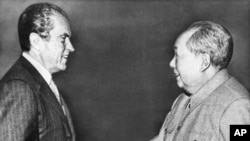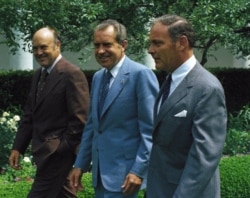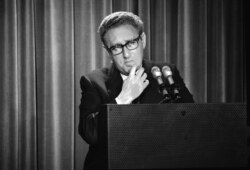In 1972 US President Richard Nixon visited the People’s Republic of China, ending years of estrangement between the two countries and lifting the bamboo curtain China had been hidden behind since Mao Zedong launched his Cultural Revolution in 1966.
“The week that changed the world,” was how Nixon dubbed his bold trip, which was pulled off after months of secret negotiations conducted by his then-National Security Advisor, Henry Kissinger. Reminiscing later about the visit, Nixon said: “We were embarking on a voyage of philosophical discovery as uncertain, and in some ways as perilous as the voyages of geographical discovery of an earlier time.”
The U.S. leader had shocked the world a few months before the trip by announcing his intention of undertaking one, a plan that surprised many in the White House, too, including Alexander Haig, one of Nixon’s advisers.
Haig was taken aback when Kissinger left the Oval Office one day and told him, “Al, this fellow wants to open relations with China.” Haig responded: “Not a cold war warrior like Nixon.” To which Kissinger retorted, “I think he has lost control of his senses.”
Forty-eight years on, America and China are embarking on another perilous voyage, filled possibly with even greater uncertainty than encountered in the 1970s. The coronavirus pandemic has triggered, say analysts, the start of an historic decoupling of the world’s two leading economies, America and China.
It has given added impetus to an increasingly shared narrative in the US and in other Western democracies that China cannot be trusted, the result of a series of aggressive policy moves by Beijing, say Western officials. They cite a growing military assertiveness by China with Asian neighbors, a crackdown on the former British colony of Hong Kong, predatory lending practices seemingly aimed at catching countries in a manipulative debt trap, and weaponizing commerce.
Western powers fear Beijing is out to re-shape the liberal world order, subscribing to a growing view that not only does the Chinese Communist Party want to ensure its continued rule at home but to make China the number one global power.
“In both the United States and Europe, the severity of the health and economic crisis driven by the pandemic has raised the stakes for policy on China and — especially in the UK, Germany, France and the wider EU — is tipping the balance towards those who advocate for a harder line on China,” says Leslie Vinjamuri of Britain’s Chatham House.
Nixon’s vision
So is the West turning away from Nixon’s vision of China, closing an opening he created and now set on the path of reversing what he achieved? The answer is no. In many ways Western leaders are grappling now with the same dilemmas and challenges he faced, and like Nixon they are not coming up with any easy answers.
For all of Nixon’s soaring rhetoric during the trip about what rapprochement would mean for America and China in the future, he was focused mainly, in fact, on near-term policy goals. In a speech in Shanghai he talked enthusiastically about “what we will do in the years ahead to build a bridge across 16,000 miles and 22 years of hostilities which have divided us in the past.”
But the number one priority of the opening with China was to frighten the Soviet Union, which had fallen out Beijing. “By opening relations with China we would catch Russia's attention and get more leverage on them through playing this obvious, China card,” Winston Lord, a staffer on Nixon’s national security team, later noted.
In hindsight, Nixon did not have much to lose and a lot to gain by opening up relations with China. His credentials as a Cold War warrior helped to quiet right-wing dissent inside the Republican Party to his outreach. Conservative leader Barry Goldwater was persuaded by Nixon to support the trip on grounds that a rapprochement with China would terrify Soviet Russia.
That indeed it did, say historians of Nixon’s diplomacy and Russian officials of the time. When Nixon announced he would visit the PRC, the news hit the Kremlin “like a bolt from the blue,” according to Georgii Arbatov, an adviser to then-Russian leader Leonid Brezhnev.
Arbatov added: “My colleagues said, ‘America will be China’s ally when Nixon visits Beijing, anything could happen. Where will it end?’” The Russians were so alarmed that within days of Nixon’s announcement, they invited him to Moscow and restarted stalled nuclear arms talks.
Vietnam
Aside from frightening Russia, Nixon had another near-term policy aim. He was looking for a way to exit the war in Vietnam and was fearful that growing Chinese involvement in neighboring Laos might escalate the conflict.
“Kissinger and Nixon wanted to get help in resolving the Vietnam War. By dealing with Russia and with China we hoped to put pressure on Hanoi to negotiate seriously. At a maximum, we tried to get Russia and China to slow down the provision of aid to North Vietnam somewhat. More realistically and at a minimum, we sought to persuade Russia and China to encourage Hanoi to make a deal with the United States,” Lord later said.
Nixon failed in that aim.
“In the end, the graceful exit never came. China continued its flow of arms, material, (and some Chinese soldiers) in support of North Vietnam’s final conquest of South Vietnam and America’s humiliating retreat,” scholar Joseph Bosco wrote in a 2015 article for the Harvard Law School’s National Security Journal.
The West’s gamble
For the longer-term Nixon harbored grave doubts, both before and years after the opening with China, about the possibility of co-existence with Communist China. In a Foreign Affairs magazine article in October 1967, he proposed a strategy combining deterrence and dissuasion, saying, in the short run “this means a policy of firm restraint, of no reward, of a creative counter-pressure designed to persuade Peking that its interests can be served only by accepting the basic rules of international civility.”
He warned: “Conceding to China a ‘sphere of influence’ embracing much of the Asian mainland and extending even to the island nations beyond . . . would not be acceptable to the United States or to its Asian allies.”
And he struggled with a similar dilemma faced by Western leaders: How to balance containing Communist China without isolating it? He feared dangerous consequences of “leaving China forever outside the family of nations, there to nurture its fantasies, cherish its hates and threaten its neighbors. There is no place on this small planet for a billion of its potentially most able people to live in angry isolation.”
But in the article he emphasized: “The world cannot be safe until China changes. Thus our aim, to the extent that we can influence events, should be to induce change. The way to do this is to persuade China that it must change: that it cannot satisfy its imperial ambitions, and that its own national interest requires a turning away from foreign adventuring.”
In the years after the opening with China, he was more hopeful but wary, recognizing the risks but thinking it had been worth the gamble. But by 2000 his mood had darkened considerably, echoing his thinking in the 1960s. He confided in an interview with New York Times columnist William Safire, one of his former speech-writers, that, “He was not as hopeful as he had once been: ‘We may have created a Frankenstein.’”







